Overlay and Stroma in Mushroom Cultivation
The process of cultivation psilocybin mushrooms is not only joy and pleasure. There are also difficulties and failures. Sooner or later every mushroom cultivator comes across them. Here I want to show you one of the most common problem in the growing process — overlay, stroma and related issues.
What is overlay and stroma
I have good news and I have bad news.
The good one — overlay and stroma are not contaminants. There is a chance to fix the problem.
The bad one — growing conditions for pinhead initiation have not been met. So, you might not get harvest at all!
Mushroom growers don't distinguish the difference between overlay and stroma. Visually it's the same issue, because they look alike.
❗️Paul Stamets shares two definitions. He admitted overlay caused by wrong fruiting conditions and stroma caused by genetic changes
Overlay — is a dense mycelial growth that covers the casing surface and shows little or no inclination to form pinheads. Mainly it caused by prolonged mycelial growth (colonization period) into the casing layer. 100% colonized bulk substrate are at such a risk. However, there are chances to fix the problem
Stroma — is a dense, mat-like growth of mycelia or cushion-like aggregation of mycelium forming on the surface of composts or casings and indicative of somatic (vegetative), not generative growth. Such mycelium can absorb nutrients, but can't produce mushroom fruit bodies. At the fruiting stage the cultivator won't be able to influence such genetic changes in any way. Although inappropriate fruiting conditions can be a trigger for such genetic changes as well.
How to identify overlay
Visually it is a dense snow-white layer of mycelium resembling fluffy cottony clouds.
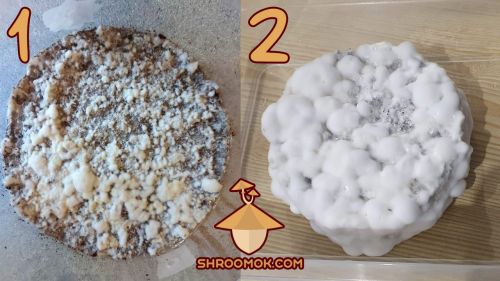
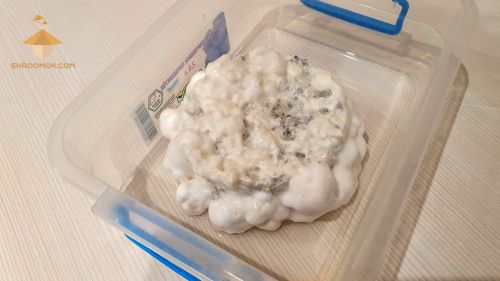
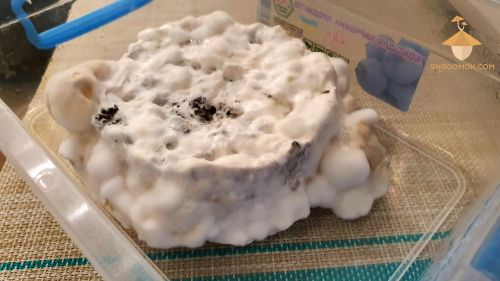
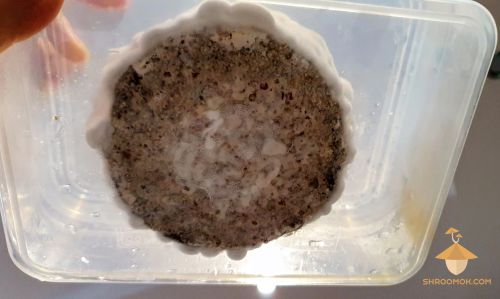
The difference between normal and overlayed mushroom cakes.
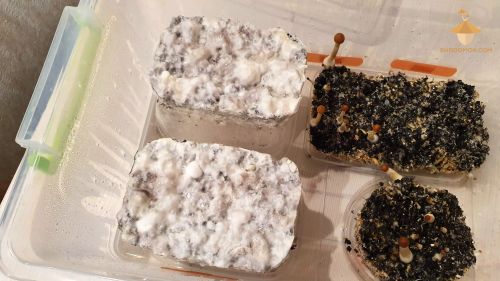
To the touch neglected form of overlay like cotton pads or polyurethane foam.
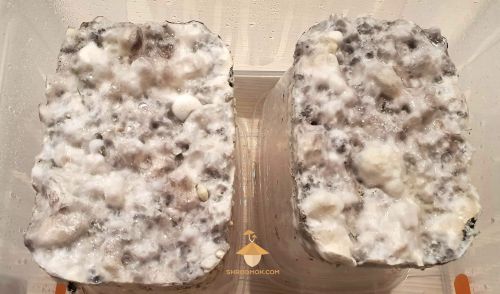
It can turn into a dense dry crust that block mushroom cake and doesn't allow air and moisture to pass through. Overlay often accompanied by Mycelium secondary metabolites or mushroom pee (phase 2 on the photo).
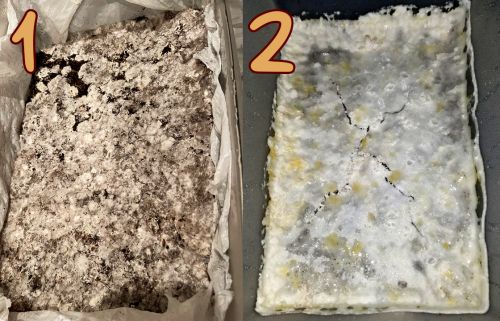
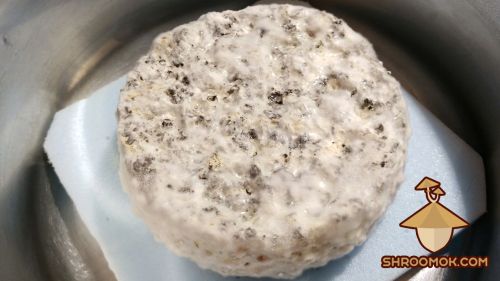
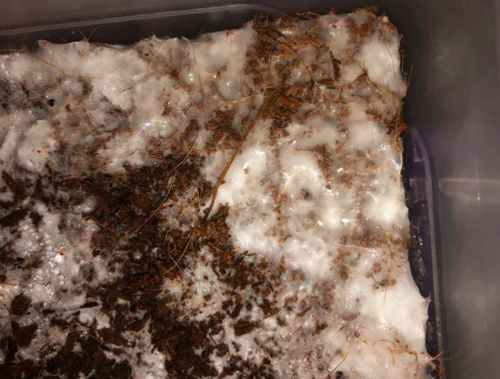
Main causes of overlay
⛔️ Overlay can form in a spawn jar due to prolonged colonization period in incubator. However, it's not a problem. Remove mycelium overgrowth and use grain spawn for the next step (Spawn to Bulk).
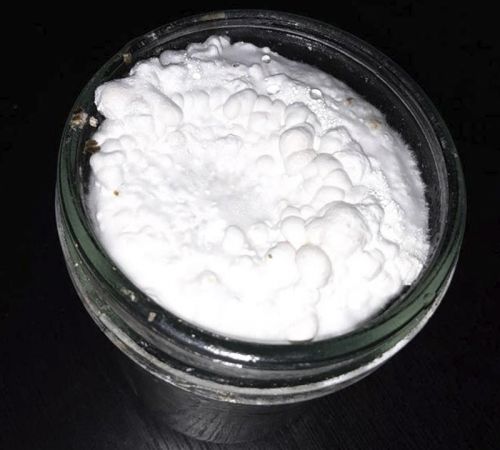
⛔️ Prolonged bulk colonization period. You should provide fruiting conditions when 70-90% of the top layer is covered with mycelium.
Here is an example when fruiting conditions for mushroom cakes were provided too late. Top layer is fully covered with mycelium and fluffy clouds started to form.
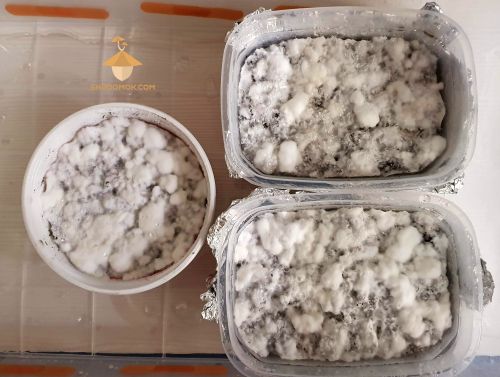
⛔️ Too dry or too wet top layer and bulk substrate. Control bulk substrate field capacity to have perfect moisture balance.
⛔️ Imbalanced fruiting conditions: CO2, temperature, relative humidity.
Use air monitor to track basic fruiting parameters during mushroom fruiting period: temperature, relative humidity, CO2 level
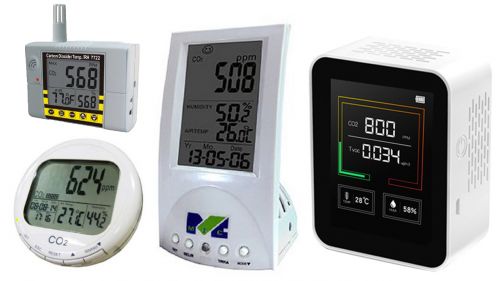
Shroomok's Choice on Amazon:
Mini Air Analyzer 3-in-1: CO2, Temperature, Humidity $45.99
8-in-1: CO2, Air Pollution, Temperature, Humidity $59.98
⛔️ High carbon dioxide (CO2) concentration (above 1000-1500 ppm) for a long period.
Recommended CO2 concentration for Psilocybe Cubensis is 600-1000 ppm
⛔️ Low relative humidity in the fruiting chamber (less than 85%) + high CO2 concentration.
⛔️ High temperature for a long period. 77F (+25°C) and higher for Psilocybe Cubensis.
⛔️ High evaporation rate + high RH + high CO2. The humidity level in the fruiting chamber is high, but it is provided by extreme evaporation from the top layer, thus mushroom cake dries out quickly. In combination with high CO2 dry crust appears on top layer.
⛔️ Acid grain spawn and bulk substrate (pH 6.5 and lower). To prevent substrate acidification:
- Adjust the grain pH to 7.0-7.5. Use a combination of hydrated lime and gypsum. Approximately 5-10 grams of lime and gypsum are added per one kilogram of cooked grain.
- Adjust the bulk substrate pH 7.5-7.8. Use hydrated lime to raise the pH at the very beginning, at the mixing stage and then use gypsum in the amount of 2-10% of the amount of dry substrate to prevent pH fluctuations later.
Gypsum (calcium sulphate) is not used to raise the pH. Gypsum contains both calcium carbonate and sulphur. Therefore, it tends to maintain the pH near neutral, preventing pH fluctuations
- Adjust the casing substrate pH 7.5-8.0 by using buffering agents like hydrated lime.
Details are in Spawn to Bulk and Casing
⛔️ Strain degeneration, aged genetics. As mushrooms strains get older, they begin to develop anomalies as random mutations accumulate. Such genetics are capable of vegetative (mycelium) growth only, where mycelium absorb nutrients, but can't form pins and develop fruit bodies.
⛔️ Aged mycelium. If the grain spawn jars were stored for too long (over 3 month) this can cause genetic changes and stroma growing.
⛔️ Overlay and stroma is often a complex of several factors:
- dry mycelium due to high evaporation rate + high CO2 = overlay
- high CO2 + high RH and water drops on mycelium = overlay
- high t° + low RH + high CO2 = overlay
- low RH + high CO2 = overlay
- dry top layer + high CO2 = overlay
- dry top layer + low RH + high CO2 = overlay
- any of parameters (triggers) + genetic issues = stroma
If you have constantly high temperature in the fruiting chamber, too high or too low relative humidity (RH) with extreme CO2 level, mycelium continue vegetative (mycelial) growth and won't form pinheads.
🔴 Recommended: Fruiting period. Pinhead initiation and mushrooms growth parameters for Psilocybe Cubensis
How to fix overlay and initiate pin setting
It is impossible for mushroom pins to break through the thick layer of mycelium and start fruiting. Because the top layer of mycelium is literally dead.
Stage 1 on the photos below are mushroom cakes at the start of overlay formation. Stage 2 - is already overlayed cake.


Such problem can be handled by adjusting fruiting conditions, fork-tek, using casing or pseudo-casing layer
1. Fix fruiting conditions
First stage of overlay (phase 1 on the photos) is easy to fix by balanced fruiting conditions.
Reduce excessive CO2 level by increasing fresh air exchange. Gently introduce fresh air every 4-6 hours manually. Just open the lid of the tub for 1-2 minutes.
Maintain relative humidity around 90%. The walls of fruiting chamber should be covered with small water drops.
Air temperature in the fruiting chamber should be around 70-74°F or +21°..+23°C.
In 5-10 days first pins should appear
Great thing to use is aquarium air pump for constant FAE in the growbox. For sufficient FAE use air pump for 60 Gallons per hour and higher. This would be enough for the fruiting chamber of 30-80 Qt
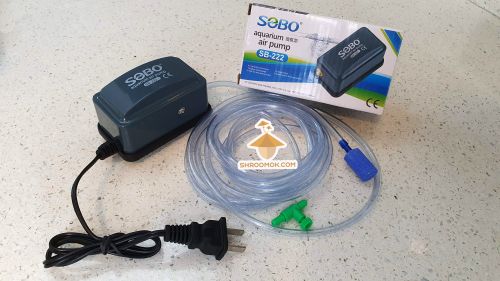
The aquarium air pump should be switched on 12-24 hours/day during this hard period. In this way fresh air move in the growbox all the time. There is a rock at the end of the hose, it should be dropped into a jar of water. This will filter the incoming air against contams.
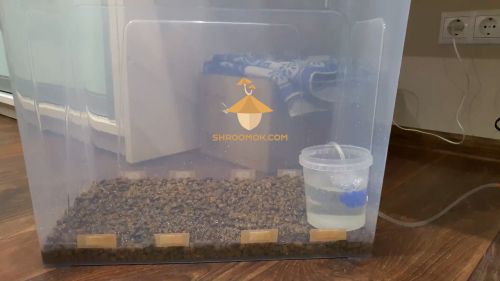
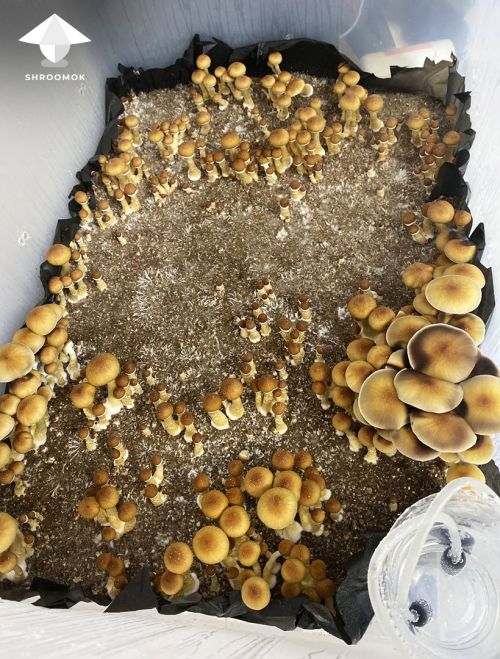
Shroomok's Choice on Amazon:
Quiet Oxygen Pump for 20-100 Gallon - 2 Outlets - $15.99
Powerful Air Pump - for 20-200 Gallon - 2 Outlets - $22.89
2. Fork tek and Casing
You may think this method is too cruel, but it works great for significant overlay (stage 2).
This method also works for Psilocybe Natalensis overlay, which is the main issue for this species.
Check out real case: Natalensis grow bag fruiting and overlay problems
Step 1. Scratch the mycelium with sterile fork aka Fork Tek.
The fork should be sterile! Wipe it with iso alcohol. Otherwise, you increase the risk of contamination
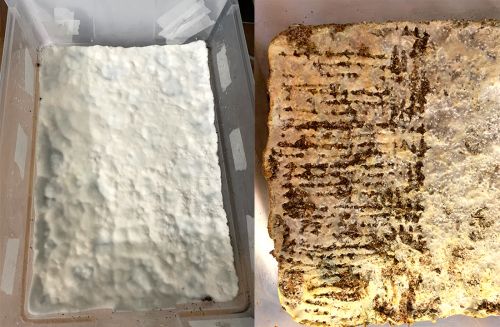
In this way we remove the crust and give an air access for mushroom cake. But don't scratch it off completely!
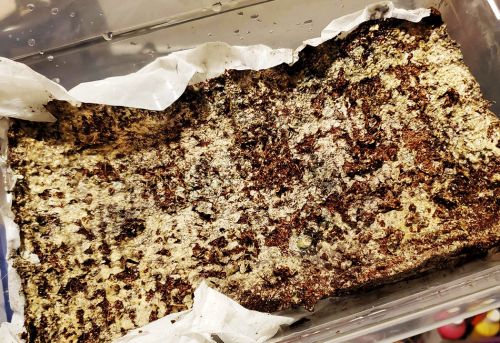
Step 2. Make a casing or pseudo-casing layer
Casing layer recipe and advantages
Grain for spawn is a highly nutrient substrate for producing mycelium, till too much nutrients mycelium continues colonisation phase and don't want to produce mushroom fruits.
Bulk substrate (coco coir mix) is a source of water and less nutrient.
True casing layer is a non-nutrient substrate that promotes pinning. The mycelium thinks it’s getting choked off and fights to fruit so it can deliver its spores and live on. Casing layer is a sign for mycelium "No more nutrients! Hurry up! Go go go, save your genes!" And boom! Fruits are coming for sporulating!
The recipe for casing layer:
- sphagnum aka peat moss - 2-3 cups
- vermiculite - 1 cup
- hydrated lime aka calcium hydroxide - 0,5-1 tbsp
- water - 1-1,5 cup
Sterilization in a pressure cooker or instant pot at 10-15 psi for 1 hour.
Let the jar cool down to room temperature.
Pseudo-casing layer recipe
Less effective method, because coco coir is relatively nutrient. However if you don't have a peat moss it works as well.
The recipe for casing layer:
- coco coir - 130g or 1/5 coco brick
- vermiculite - 1.6 cups
- hydrated lime aka calcium hydroxide - 1 tbsp
- water - 3.6 cups or 0.9 qts
Check field capacity (balanced moisture level). A good way to test it is to grab a handful of the substrate mixture and squeeze it in your hand.
⛔️ If you are unable to squeeze out any water, it is too dry. Add more chilled boiled water.
⛔️ If a light squeeze causes a stream of water to come out, it’s too wet. Squeeze the substrate before use.
✅ You want to be able to squeeze the mixture as hard as you can, and only have a few steady drops come out to have a field capacity moisture level. This is perfect!
Make sterilization or pausterization as for bulk substrate in bucket or pot. Or you can fill the jar with ready substrate and put it in pressure cooker at 10 psi or instant pot for 1 hour or pausterize in a microwave. Let the jar to cool down to room temperature.
Step 3. Cover the cake with casing layer
Mushroom cake right after the fork tek.
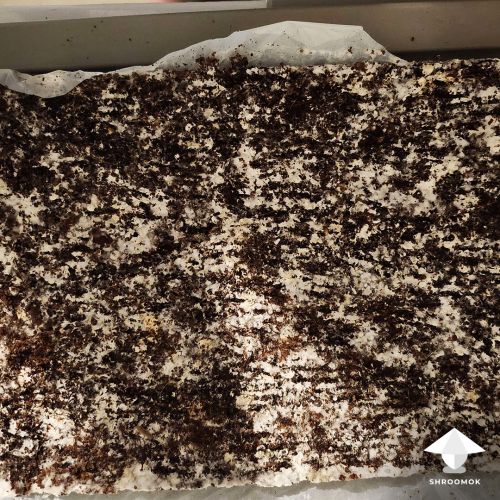
Add 1/4-1/2 inch or 0,5-1,5 cm of casing layer on top of the cake. Casing doesn't require colonization conditions, provide fruiting conditions right after casing
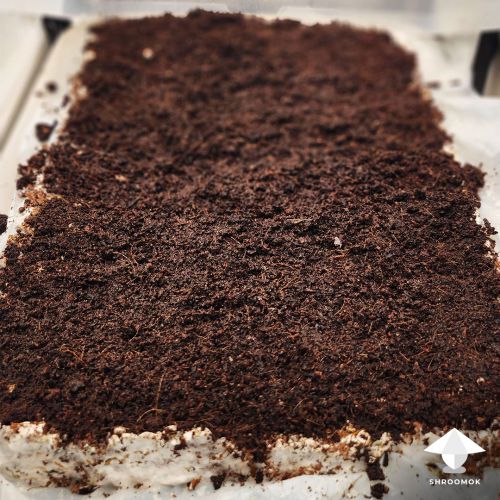
Usually in 3-7 days first pins appear
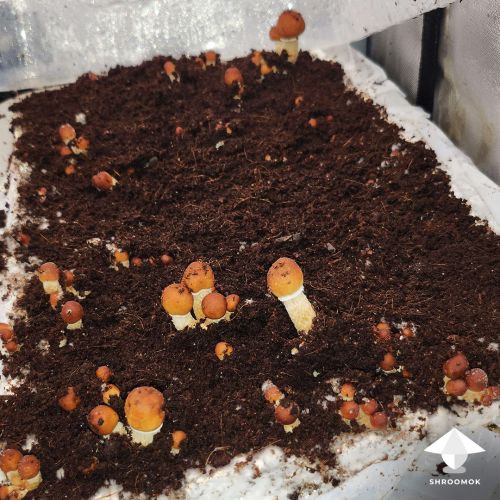
Mushroom blooming!
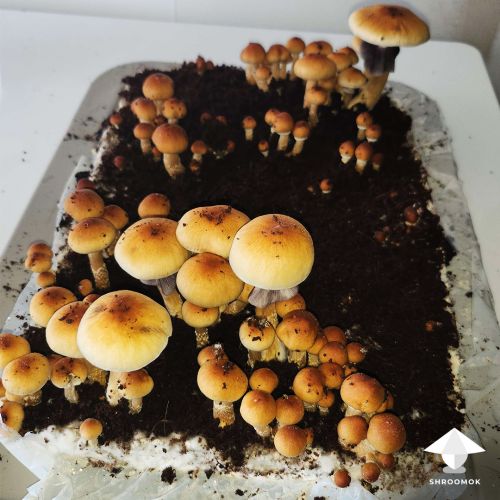
3. Fork tek and rehydration with cold shock
This method will be useful for dry cake with overlay.
Scratch the overlay
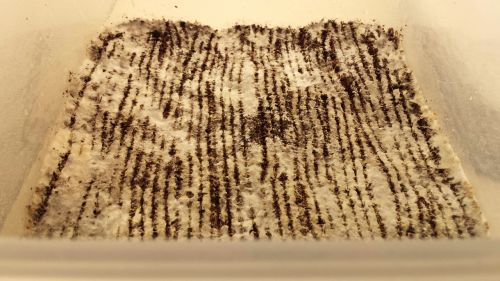
If overlay wasn't removed, then rehydration is absolutely useless. Mycelium will work like a film and won't absorb water. The demonstration in the photo below
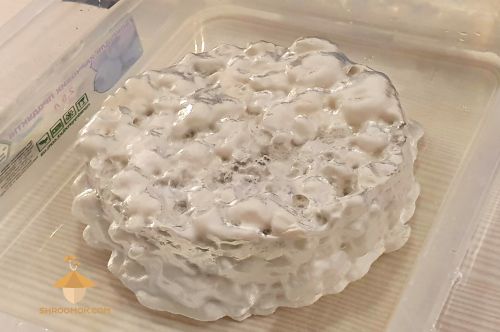
Soak mushroom cake/block in cold water with added ice for 2-4 hours. Cold shock works as a trigger for pinning, can inhibit the aggressive mycelium growth and stimulate pin setting.
Recommended: How to rehydrate mushroom cake
Casing layer after soaking in water and cold shocking is optional, but highly recommended!
Case with Salty Coco Coir or How Sodium in bulk substrate causes mycelium overlay
Here is an exceptional mushroom growing story worth telling you about. Details in the dialog!
QN: Hi Shroomok! Thank you so much for your help and interest in my issue. Finally, I found the parameter that was blocking fruiting and causing the constant overlay. I've described the problem and would like to share my case with shroomok community. Maybe you'll add it to your blog post. I hope it will be useful to someone. Regards, QN
Hello, I once came here with a problem, and I received tremendous support from you. You are an amazing community! After 8 months of failures, I solved my issue, and I want to share my insights with you.
Who might be affected by this problem – growers living in tropical countries.
The issue – constant OVERLAY and zero pins due to high salinity of coconut coir. A few examples:
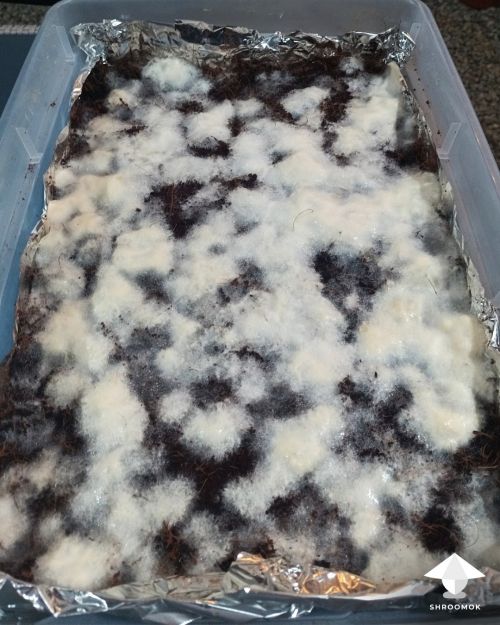
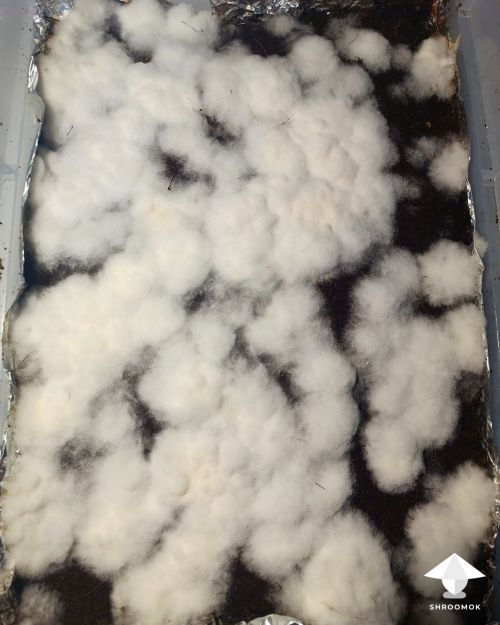
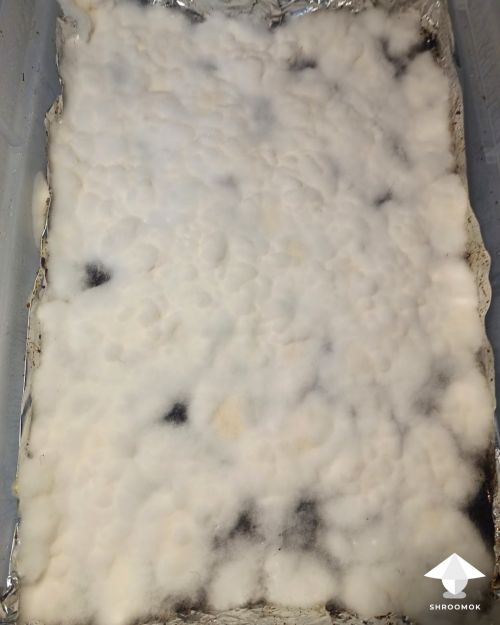
Introduction – I am from Poland, and 20 years ago, I successfully ran a mushroom farm, learning the basics of cultivation and growing on agar. Now I live in Costa Rica and decided to start growing again, beginning with the simplest strain, Golden Teacher.
Observations – the mycelium colonized the grain (corn, rye) at a very fast pace. After inoculating the substrate, colonization occurred literally within a few days. Upon providing FC, a thick mycelium layer always formed within a few days, up to 2 cm thick. Forking (fork-tek), using succulent soil as a casing, and cold shocking didn’t yield any results; the mycelium always grew excessively, forming a thick layer but never produced fruit bodies. There were also large amounts of metabolites, and the mycelium was clearly very stressed.
Reflections – I had ideal colonization conditions, perfect fruiting conditions; there had to be some damn parameter in the substrate. Around the world, people buy COMPRESSED coconut coir in supermarkets or garden stores, and this coir likely comes from coconut plantations that probably don’t grow on the beach. These are plantations.
In Costa Rica, coconut coir is sold in bags from local producers, but there are no plantations here; coconut palms only grow on beaches by the ocean, so they may be salty.
After purchasing a salinity tester, I found that the coconut coir had 1300 ppm of salt! And that was the damn parameter!
Solution to the problem – salty coconut coir (mine was 1300 ppm, Ph 6.0) should be rinsed 4 or 5 times. For the first 4 rinses, leave the coir in water for 30 minutes and change the water, and ideally, leave the final rinse for 12 hours. After this process, you will get 40 ppm of salt and Ph 7.0.
First results – I used the salty, colonized substrate I already had as a spawn and mixed it with desalted coconut coir. After 5 days of colonization, I moved it to FC, and after another 10 days, the first fruit bodies appeared!
8 months of failures, but what knowledge and satisfaction I’ve gained! I hope my experience and observation help at least someone from tropical countries.
Shroomok: QN, huge thank you for sharing your experience! It's a great pleasure to share your story.
Your case confirms that Sodium (Na) is what is really poisonous to mycelium!
Sodium (Na) is an antifungal agent and inhibits the growth of fungal mycelium, affect mushroom metabolism. As a result inhibits mushroom pinning and fruit bodies development.
That's why baking soda (NaHCO3) that contains (Na) never used for substrates' pH adjusting. Salt (NaCl) never been known as a beneficial additive. Although salt and soda are used for making salt/soda application for treating small contaminated areas on mushroom cake. Such patch helps to seal the contaminated area and inhibit fungal pathogen, because Sodium (Na) affects any type of fungi, including molds.
Coming back to your case, I once had the same problem with salty coco coir. In my case it was also no name coco coir, but in BRICKS (compressed). I don't remember exactly what was the ppm level on the tester, around 1200 ppm or so. I had to soak and wash coir 3 times to reduce it. I briefly mentioned this factor in Spawn to bulk and Casing article. But I thought it's very rare case to talk about, just my own one-time accident. Now I see, I'm not alone. Moreover, this is a problem that anyone can face, not just growers living in tropical countries.
QN: I’m glad I was able to figure out the cause of the problem, and now I’m harvesting huge yields! It’s great that even the mushrooms outdoors, in the garden and in pots, are growing beautifully. I see that I’m not the only one who has encountered the issue with salty coco coir – it seems to be more common than I thought.
Useful notes for overlay treatment and prevention
🔴 Usually overlay indicates faults in the growing process. Check your growing conditions first. Early overlay is possible to fix by changing some fruiting parameters.
🔴 For fork tek scratching use sterile fork (treat it with alcohol). Don't touch casing layer with your hands. This can be a vector of contamination. Use sterile gloves (treated with alcohol) when work with mushroom cake.
🔴 After fork-tek you may notice that mushroom cake is completely dry (more than 3 weeks after providing fruiting conditions). In this case rehydration is recommended.
🔴 Casing layer is optional, but highly recommended. Use casing layer 1/4-1/2 inch or 0,5-1,5 cm after bulk colonization to prevent overlay and stimulate pinning. Casing also works as a treatment for overlay and pinhead initiation.
🔴 Fork-tek is stressful for mycelium. It takes about 1-2 weeks for recovering and start of pinning. Be patient.
🔴 Overlay is a frequent companion of Tomentose mycelium (fluffy, cottony, cloudy). Rhizomorphic mycelium is less prone to overlay.
🔴 If you notice aggressive cottony mycelium growth in spawn jar/bag then mix spawn to bulk in 1:3 or 1:4 ratio. Less nutrients is better.
🔴 Even if you haven't made mistakes during the colonization and fruiting phase the cause of stroma overlay may be due to strain genetics. In this case the mycelium is only capable for vegetative growth. It will actively consume nutritions, but will not be able to form fruiting bodies. Alas, you won't get mushrooms from such cake even in ideal fruiting conditions.
🔴 High Sodium (Na) and low pH level of bulk substrate. Check the pH and salinity of your bulk substrate before using it.
More failures with overlay
One more example with overlay in my growing experience was Psilocybe Cubensis F+. It was aggressive colonization of grain substrate. The first signs of mycelium in the jars were already 4 days after inoculation. When casing was 60% colonized with mycelium the fruiting conditions were provided.
Overlay happened at the fruiting stage in the growbox at +21°...23°C, humidity 95% and FAE 4-6 times a day - fruiting conditions that were perfect for other strains.
Eventually, I haven't got mushrooms from these cakes at all.
I played with different options to promote pinning. Each mushroom cake with stroma overlay was subjected to a number of experiments: fork-tek, fork-tek with rehydration, cold-shocking. Casing layer promote some hyphal knots that stalled later.
None of the cakes were successful. They covered with a new white fluffy mycelium. No pins. No shrooms.
After 75 days after inoculation and all experiments I said goodbye to three Psilocybe Cubensis F+ cakes.
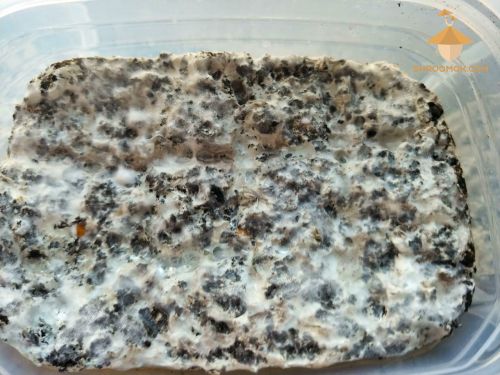
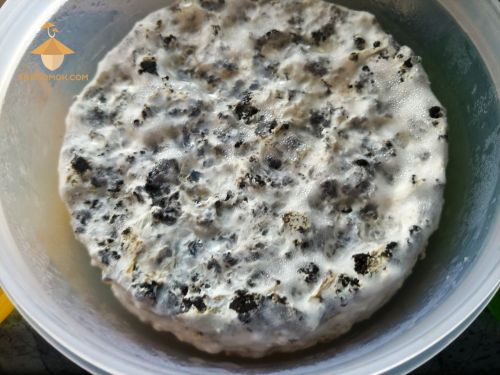
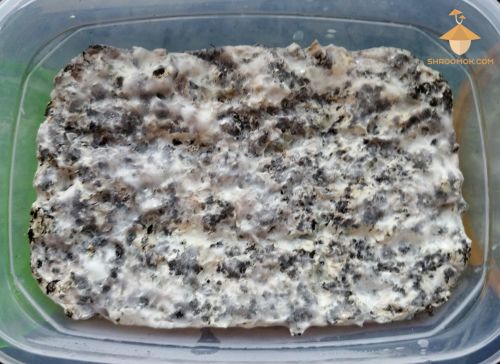
Accompanying problems with overlay
🔴 Check out: Mushroom aborts
🔴 Check out: Mycelium metabolites or mushroom piss
Afterwords
Check out the section Contams & Troubleshooting to explore more cultivation problems and contaminations.
More photo examples in 📸 Growing Problems photo gallery
More overlay examples in Overlay photo gallery
Join Shroomok Community on Discord and Reddit for questions and sharing experience.
If you find this guide helpful, please support me with a cup of coffee on ☕️ buymeacoffee
You can also leave your questions and comments on this page below ⬇️
Have a happy growing and healthy shrooms!
Peace, Shroomok ❤️


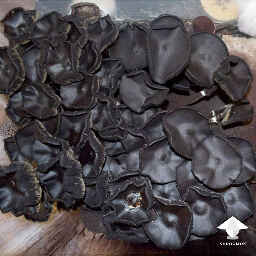
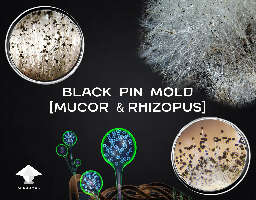
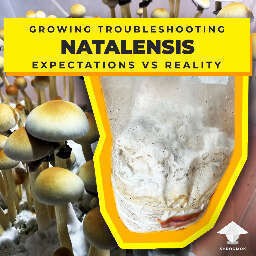
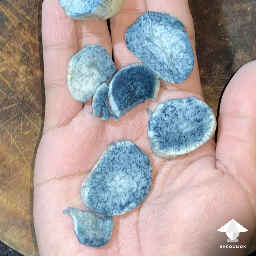
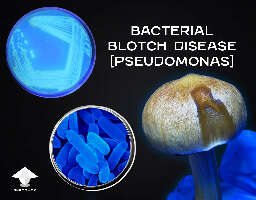
Comments
I read your whole article. Haven't found much micellium yet. It's dry in So Cal, Los Angeles, San Fernando Valley. So I mist them and alcohol them. Try not to get to clumpy or soggy. Hard to find a happy medium. But I found some old grow dung dirt with old spores and hooked them up outside and the freshies will grow in my towel closet in the bathroom. Then I took some pieces of P.E. shrooms and,1/2 top and 1/2 stem and crumbs from bottom of bag, and it has micellium growing. That's in my bathtub. If I have success,I will have 9 kids of shrooms. I'll be praying hard. ❤ I'm a 67 year old lady baby boomer. I love shrooms for every reason....💋🤙🏼💎💃🏼🎬
I think you need to be more clear and concise about it's very confusing you have a bunch of extra information in there that you don't need to have and so therefore the conclusion is we we still have a bunch of unanswered questions
@Donald_Gordon
Your claim definitely deserves Oscar for concise. 230 symbols of complete uncertainity.
Please, go ahead Mr. Gordon, ask your questions here or on Discord / Reddit
I've followed the tips in this article. Unfortunately I lost 2 cakes to aggressive overlay, 1 cake to contamination, and it looks like I'm going lose 2 more :( Live and learn. The last set of 2 has just come back with a vengeance. Oh well. Maybe I should stick to spores instead of LC.
@big_henry please share photos of your problem on Discord or Reddit? I'll check them out and hope we can save some of your cakes; and figure out what's causing the problem to avoid mistakes in the future
I love all your work, thanks a lot for all the wisdom.
Hi shroomok, I had an overlay on one B+ box because I missed to transfer it soon enough to the fruiting stage. So I followed your guide, scrapped it off, put a fingerthick layer of coconut and the mycelium colonized very well as is should be. Now I seems to me as a beginner, the "impulse" to form pinheads is not there. Temp has been 23 degrees, humidity about 95 and I have a blue light installed. Air is given by me 3-4 times a day by me opening the lid manually, what has been sufficient with my last flushes. Growing stopped about 10 days ago and nothing happens. Acutally mycelium colonization stage at the top is about perfect to form pinheads. What do I need to change in my setup to have a chance to get mushrooms? Is cold shock something I need to perform to give the impulse?
@Kitty, how long has it been since you made pseudo-casing layer?
And how long since the top layer colonization?
It’s common for the mycelium to appear stalled after top layer colonization and/or transitioning to fruiting conditions as it uses this time to gather energy for pinning. Your temperature, FAE, and humidity levels seem fine 👌
I’d recommend reducing the humidity slightly to 90–92% to allow some evaporation, as this also can help stimulate pinning. Don't do anything extra till day 15-18 of the fruiting stage (I mean 15-18 days after top layer colonization).
Colonisazion of the pseudo layer took about one week. Since 14 days nothing really appens any more. I will reduce the humidity as you suggested.
@Kitty, let's check the progress on day 18, okay?
Feel free to send me a photo of your cake in DM - Reddit, Discord, IG, X or by sending me an email - you can find all links on the main page in footer. It would be much easier to figure out what's wrong
Add comment